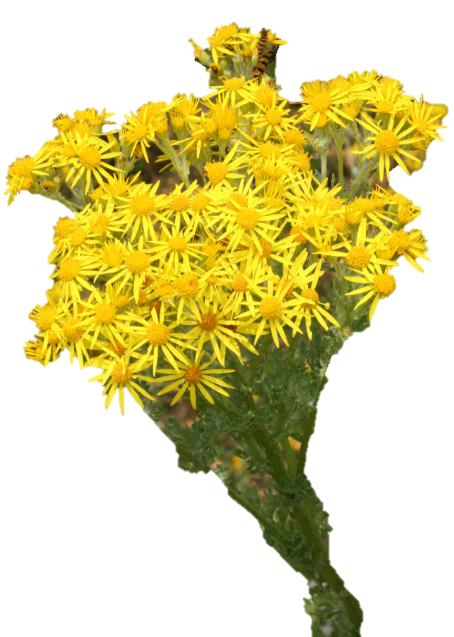
Have you noticed the bright yellow flowers appearing in shaggy clusters along Pacific County’s roads and in vacant lots in recent weeks? This plant is tansy ragwort (Jacobaea vulgaris), and it is not a nice plant. Tansy ragwort is highly toxic to humans and livestock. When ingested it can cause bloody diarrhea, liver failure, and a myriad of other unpleasant symptoms, including death. Alkaloids found throughout the plant are metabolized into more toxic forms by enzymes in the liver. These toxic metabolites accumulate and eventually cause irreversible damage, including cirrhosis and liver failure. Chronic and repeated exposure to these toxins poses the greatest risk. Tansy is a common problem in pastures and rangeland, where it easily outcompetes native vegetation and reduces available grazing acreage. Most animals will avoid grazing on fresh tansy in the field because it has a bitter taste. But when cut and dried, it retains its toxic properties and loses the bitterness. Tansy hidden in a hayfield can be easily harvested, sold, and served as animal feed before anybody is the wiser.
Tansy ragwort also poses a threat to humans as a contaminant in our food production system. A wide variety of products, including: milk, flour, and herbal remedies can become contaminated with tansy alkaloids during production and still make it to market. Several studies have even found that honey produced from the nectar of tansy ragwort flowers contains hazardous levels of the toxic alkaloids and should be considered a threat to human health. This is one of the reasons that pediatricians recommend not feeding honey to babies.
To achieve long-term control, it is crucial that mature plants are eliminated from the population. A mature tansy ragwort plant can produce up-to a quarter-million seeds, which can remain viable in the soil for a decade or more.
Despite its wide distribution, tansy is relatively easy to control (compared to most other noxious weeds). All you need is a pair of gloves and some free time. Plants can easily be pulled-up, roots and all, by grabbing near the bottom of the stem and pulling up. Place the plants into plastic bags and dispose of them at your nearest solid waste facility. For larger infestations, the use of herbicide may be appropriate. Effective control can be achieved with products containing glyphosate, 2,4-D, and/or triclopyr (For more information regarding the use of herbicides, contact Pacific County Noxious Weed Control Board).
In Pacific County, landowners are required to control tansy ragwort identified on their property (17.10.140 RCW) and those who fail to do so may be issued a civil infraction and be required to pay an accompanying fine (WAC 16-750). The penalties are assessed per parcel, per noxious weed species, per day after expiration of the notice to control. If you have tansy ragwort on your property, get rid of it immediately. Do not wait for it to become a bigger problem than you are equipped to handle. Weed control projects can cost thousands of dollars, and that does not include any fines that you may have accrued for failure to control the noxious weeds.
Please share this information widely and take corrective action when and where you are able. Share what you know with the community. If your neighbor has tansy don’t get mad, talk to them about it! Many people see tansy every day and have no idea that it is a noxious weed. If you have any questions about the information presented here, or would like more information about tansy ragwort or other noxious weeds, contact the Pacific County Noxious Weed Control Board.
Thank you,
Jeff Nesbitt
Director
Pacific County Noxious Weed Control Board
Department of Vegetation Management